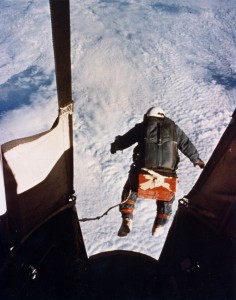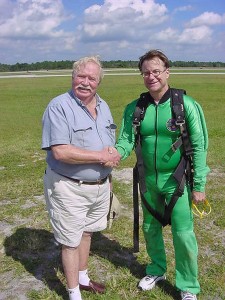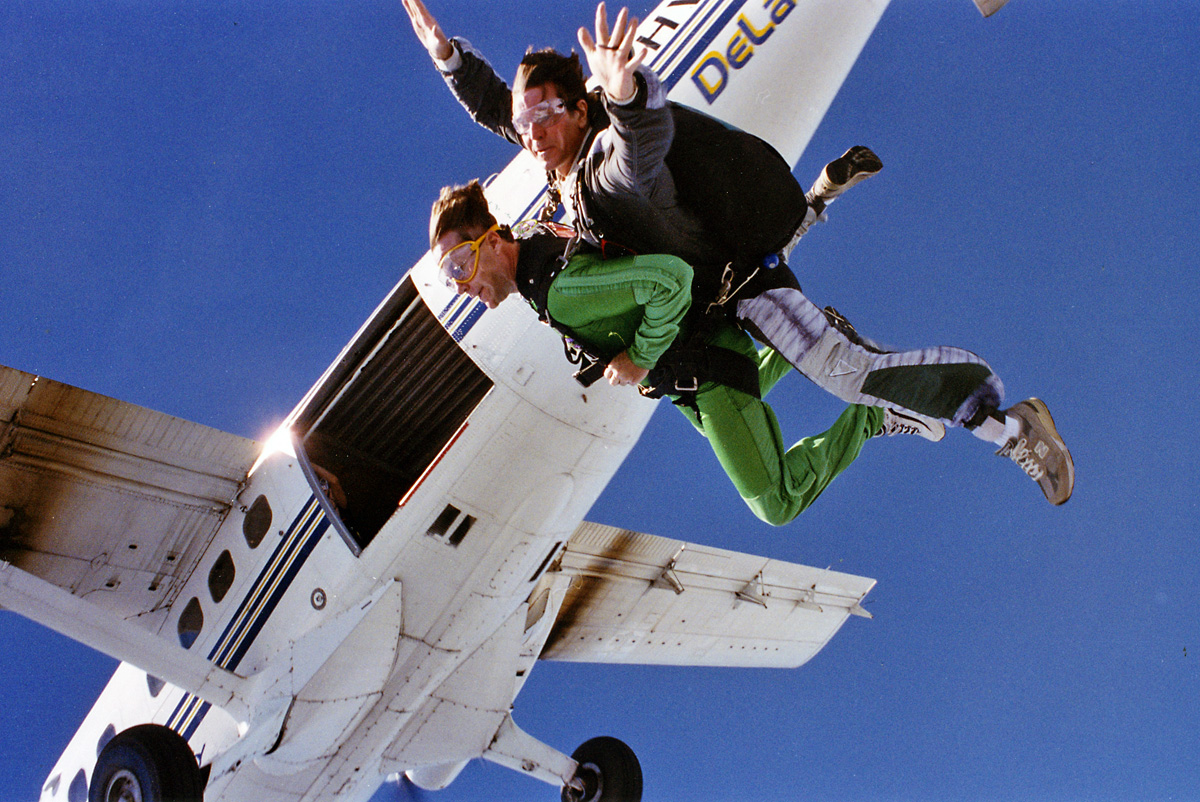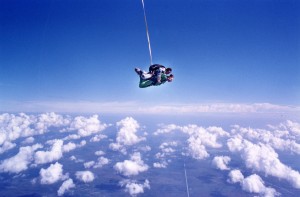What makes some people dare to do activities that most people wouldn´t even think about doing? I am sure a lot has to do with curiosity to see what will happen. A kind of leap of faith. And I don´t think these feelings stops with age. Though I am constantly amazed by people in my age, around 50, who are contemplating a laid back life with the years to come. Why on earth waste this opportunity we have, this short existence, by stopping to explore one´s limits? Right now I am reading one of the most interesting and inspiring books I have read for quite some time. A book written by James M. Clash, The Right Stuff. I am reviewing it right now, but until I have read this thriller, please enjoy this great article by Jim below which says it all. Don´t stop living, ever!
A Leap of Faith
By
James M. Clash

Tandem skydiving lets you start out high. You piggyback on an
instructor who (presumably) will not forget to pull the rip cord.
Preparing for one’s first skydive used to be a daunting proposition.
Fledgling U.S. paratroops in WWII, for example, began their training
by jumping off of 5-foot towers, so they could practice how to land,
flex their knees, then roll. Only after acquiring bruises and sprained
ankles did they get to jump out of airplanes.
Today’s neophyte can start that way, then try a tame, static-line leap
from 3,000 feet, with no free fall. Or better yet, you can skip all
that and go straight to the open door 2.5 miles up, as I discovered
when I made my own first jump. I had asked parachute world-record
holder Colonel Joseph Kittinger*, USAF retired, how to get started,
and he recommended I try a tandem jump.
In a tandem jump, the choice of when to pop your chute, your landing
and all other subtleties are left to a professional instructor who
jumps with you. Or rather, attached to you, since he (or she) is bound
to you in a configuration that joins your back to your instructor’s
front. It’s as if the two of you were halves of a Bossie-the-Cow
costume, with the instructor taking up the rear. The connecting
ligaments don’t get attached until you are ready to jump; before then,
you can walk and function independently.
Tandem jumping was popularized in the late 1980s by William Booth, an
instructor with Skydive DeLand in DeLand, FL, near Orlando. Kittinger
referred me to DeLand’s owner, Robert Hallett, a man with thousands of
jumps to his credit. He’d be my instructor and jump partner.
I was fitted into a tight green jumpsuit that gave me new respect for
women who wear spandex. Hallett, pointing to my penny loafers, asked
if I planned to wear them aloft. “Sure,” I replied. “No way,” said he.
“The wind will blow them off your feet.” Kittinger, who’d come along
to lend moral support, asked my shoe size. When it turned out to be
his own, he lent me his sneakers. Hey, it might bring me luck to wear
the shoes of a world-record holder.
So up in a small Twin Otter aircraft Hallett and I went, along with
five other conjoined pairs. At about 5,000 feet the jump door opened,
a tandem team exited, and then the door closed. There was no fanfare.
It was like a bus stopping to let passengers off.
Circling over the airport, we took another 15 minutes to reach 13,500
feet, our maximum altitude. Nervous laughter from the other jumpers
filled the cabin. Again the jump door opened and, one by one, the
tandem teams hopped out. There was no sound but the wind roaring past
the door. Eerie.
Hallett and I engaged our siamese harness, then made our way to the
door. We were the last to jump. I looked back at Kittinger, who was
seated in the copilot’s seat. He gave me a jaunty thumbs-up. I
teetered briefly, then tumbled into space.
I had badly underestimated the impact of the wind. It buffets you at
100 mph from the direction opposite to the plane’s movement, then
changes direction as you hurtle downward. Your face begins to distort
and your cheeks to flap once you hit terminal velocity, about 120 mph.
At that speed you’re dropping the length of an Empire State Building
every five seconds. My goggles, tightly fastened to my head, felt like
they’d blow off. To take my mind off how fast the ground was
approaching, I tried to concentrate on the photographer, who was
falling right next to us. (You can arrange, in advance, for
commemorative snaps to be made of your descent.)
After what I later learned was 45 seconds of free fall, I felt an
abrupt jerk. Hallett had pulled the cord. Then? Utter and unearthly
peace for six minutes as we wafted another 3,000 feet down, the
countryside below swaying side to side in silence. We landed in a
sitting position, sliding comfortably along the polished stones of the
airport’s target area.
The next night Kittinger and his wife, Sherry, and I celebrated. I
hadn’t broken any height records–but then I hadn’t broken any bones,
either. Plus, I was now a member of the jump club. I asked Joe what
he’d been thinking when he made his own historic jump. “I said a
silent prayer: ‘Lord, take care of me now.'” Kittinger then asked,
“What did you say?” I struggled for a polite way to express it:
“Something less devout.” The colonel laughed. I gave him back his
shoes.

from a helium balloon 102,800 feet above the earth. Currently, he is
consulting with Red Bull Stratos in its effort to eclipse Kittinger’s
record: Felix Baumgartner plans to jump from 120,000 feet this fall.
An interview with Kittinger appears in my book “The Right Stuff:
Interviews with Icons of the 1960s”
[http://www.askmen.com/e-book/jimclash/”]).
James M. (Jim) Clash is a seasoned adventure and business journalist.
Jim started at Forbes in 1993 as a reporter, and in 1996 was promoted
to staff writer. In 1998 he wrote a pivotal story on hedge funds,
warning investors of risks and expenses. When Long Term Capital
Management collapsed six months later, Forbes ran a national
advertising campaign “Business Reporting as Tough as Business Itself”
about his story, and he was promoted to associate editor. His book
“Forbes To the Limits” (Wiley, 2003) has received critical acclaim.
In June 2012, Clash’s first eBook, The Right Stuff: Interviews with
Icons of the 1960s was released.
Jim, a fellow and director at The Explorers Club, has purchased a
ticket to fly into suborbital space with Virgin Galactic Airways. His
adventures include skiing to the South Pole; a MiG ride at Mach 2.6 to
the edge of space; driving the Bugatti Veyron at its top speed of 253
mph; climbing the Matterhorn, 23,000-foot Aconcagua and virgin peaks in Greenland and Antarctica; and two visits to the North Pole. He has interviewed adventurers including Neil Armstrong, Chuck Yeager, Sir Roger Bannister, Buzz Aldrin, John Glenn and the late Sir Edmund
Hillary.




One comment